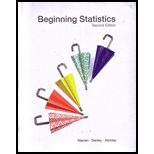
a.
To find:
The
Answer to Problem 15CR
Solution:
The required probability is
Explanation of Solution
Given:
In statistics, a measurable
The normal distribution is the most prevalent continuous
In the normal distribution (also known as Gaussian or Gauss-Laplacian) distribution, the probability density function is given by:
Where,
The normal Gaussian distribution with the following characteristics:
is called standard normal distribution.
The appropriate probability density function transforms to
A normal distribution can be converted to standard normal distribution by defining the
where
The probabilities being calculated using the
Calculation:
Given value of random variable
Thereafter, the relation
First, the
Then, from the table:
which in turn gives:
Conclusion:
The required probability is
b.
To find:
Value of the
Answer to Problem 15CR
Solution:
The value of the mean is
Explanation of Solution
Given:
Description:
In statistics, a measurable function that is used to represent outcomes or occurrences of random phenomenon as real numbers is defined as a random variable.
The normal distribution is the most prevalent continuous probability distribution function and the real world hosts a milieu of the variables that are normally distributed.
In the normal distribution (also known as Gaussian or Gauss-Laplacian) distribution, the probability density function is given by:
Where,
The normal Gaussian distribution with the following characteristics:
is called standard normal distribution.
The appropriate probability density function transforms to
A normal distribution can be converted to standard normal distribution by defining the
where
Calculation:
Given value of probability
before which the
The
Here, the mean has to be computed:
Rounding off to two decimals places gives:
Conclusion:
The value of the mean is
c.
To find:
The standard deviation for given data.
Answer to Problem 15CR
Solution:
The required standard deviation is
Explanation of Solution
Given:
Description:
In statistics, a measurable function that is used to represent outcomes or occurrences of random phenomenon as real numbers is defined as a random variable.
The normal distribution is the most prevalent continuous probability distribution function and the real world hosts a milieu of the variables that are normally distributed.
In the normal distribution (also known as Gaussian or Gauss-Laplacian) distribution, the probability density function is given by:
Where,
The normal Gaussian distribution with the following characteristics:
is called standard normal distribution.
The appropriate probability density function transforms to
A normal distribution can be converted to standard normal distribution by defining the
where
Calculation:
Given the value of probability
before which the
The
Here, the standard deviation is to be calculated:
This value rounded off to the
Conclusion:
The required standard deviation is
d.
To find:
The
Answer to Problem 15CR
Solution:
The required
Explanation of Solution
Given:
Description:
In statistics, a measurable function that is used to represent outcomes or occurrences of random phenomenon as real numbers is defined as a random variable.
The normal distribution is the most prevalent continuous probability distribution function and the real world hosts a milieu of the variables that are normally distributed.
In the normal distribution (also known as Gaussian or Gauss-Laplacian) distribution, the probability density function is given by:
Where,
The normal Gaussian distribution with the following characteristics:
is called standard normal distribution.
The appropriate probability density function transforms to
A normal distribution can be converted to standard normal distribution by defining the
where
Calculation:
Given the value of probability
before which the
The
Then, the
This number rounded off to the nearest whole number gives:
Conclusion:
The required
Want to see more full solutions like this?
Chapter 6 Solutions
Beginning Statistics, 2nd Edition
- A company found that the daily sales revenue of its flagship product follows a normal distribution with a mean of $4500 and a standard deviation of $450. The company defines a "high-sales day" that is, any day with sales exceeding $4800. please provide a step by step on how to get the answers in excel Q: What percentage of days can the company expect to have "high-sales days" or sales greater than $4800? Q: What is the sales revenue threshold for the bottom 10% of days? (please note that 10% refers to the probability/area under bell curve towards the lower tail of bell curve) Provide answers in the yellow cellsarrow_forwardFind the critical value for a left-tailed test using the F distribution with a 0.025, degrees of freedom in the numerator=12, and degrees of freedom in the denominator = 50. A portion of the table of critical values of the F-distribution is provided. Click the icon to view the partial table of critical values of the F-distribution. What is the critical value? (Round to two decimal places as needed.)arrow_forwardA retail store manager claims that the average daily sales of the store are $1,500. You aim to test whether the actual average daily sales differ significantly from this claimed value. You can provide your answer by inserting a text box and the answer must include: Null hypothesis, Alternative hypothesis, Show answer (output table/summary table), and Conclusion based on the P value. Showing the calculation is a must. If calculation is missing,so please provide a step by step on the answers Numerical answers in the yellow cellsarrow_forward
 MATLAB: An Introduction with ApplicationsStatisticsISBN:9781119256830Author:Amos GilatPublisher:John Wiley & Sons Inc
MATLAB: An Introduction with ApplicationsStatisticsISBN:9781119256830Author:Amos GilatPublisher:John Wiley & Sons Inc Probability and Statistics for Engineering and th...StatisticsISBN:9781305251809Author:Jay L. DevorePublisher:Cengage Learning
Probability and Statistics for Engineering and th...StatisticsISBN:9781305251809Author:Jay L. DevorePublisher:Cengage Learning Statistics for The Behavioral Sciences (MindTap C...StatisticsISBN:9781305504912Author:Frederick J Gravetter, Larry B. WallnauPublisher:Cengage Learning
Statistics for The Behavioral Sciences (MindTap C...StatisticsISBN:9781305504912Author:Frederick J Gravetter, Larry B. WallnauPublisher:Cengage Learning Elementary Statistics: Picturing the World (7th E...StatisticsISBN:9780134683416Author:Ron Larson, Betsy FarberPublisher:PEARSON
Elementary Statistics: Picturing the World (7th E...StatisticsISBN:9780134683416Author:Ron Larson, Betsy FarberPublisher:PEARSON The Basic Practice of StatisticsStatisticsISBN:9781319042578Author:David S. Moore, William I. Notz, Michael A. FlignerPublisher:W. H. Freeman
The Basic Practice of StatisticsStatisticsISBN:9781319042578Author:David S. Moore, William I. Notz, Michael A. FlignerPublisher:W. H. Freeman Introduction to the Practice of StatisticsStatisticsISBN:9781319013387Author:David S. Moore, George P. McCabe, Bruce A. CraigPublisher:W. H. Freeman
Introduction to the Practice of StatisticsStatisticsISBN:9781319013387Author:David S. Moore, George P. McCabe, Bruce A. CraigPublisher:W. H. Freeman





